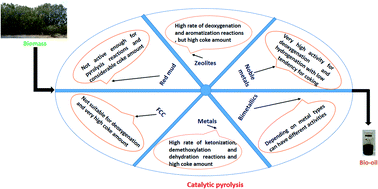Progress in understanding the coking behavior of typical catalysts in the catalytic pyrolysis of biomass
Abstract
Catalytic pyrolysis is a promising thermochemical method to upgrade the fuel property of bio-oil through the deoxygenation of volatiles obtained from the pyrolysis of biomass. However, the formation of coke in either polymeric or catalytic form is the main obstacle in the development of robust catalysts for catalytic pyrolysis. Up to now, there have been numerous catalysts developed and evaluated for the catalytic pyrolysis of biomass, including various zeolites, metal or metal oxide-based catalysts, noble metal-based catalysts, inorganic salts, red mud, and FCC catalysts. Almost none of these catalysts are immune to coke formation, but these catalysts show distinct tendencies towards coke formation. Moreover, the varying properties of the catalysts lead to the formation of coke with varying nature. Therefore, there is a need to revisit the different types of catalysts used in the catalytic pyrolysis of biomass, especially their coking behaviour and the property of the coke formed. This could provide a theoretical reference for the further development of coking-resistant catalysts for catalytic pyrolysis. The advantages and disadvantages of each group of catalysts are investigated herein and reaction mechanism for each group of catalysts is explained. Considering the results, it can be concluded that the development of catalysts for biomass pyrolysis is still in the initial stages and further fundamental studies are required to obtain favourable catalysts with high upgrading efficiency and low coke formation.

- This article is part of the themed collection: Sustainable Energy and Fuels Recent Review Articles


 Please wait while we load your content...
Please wait while we load your content...